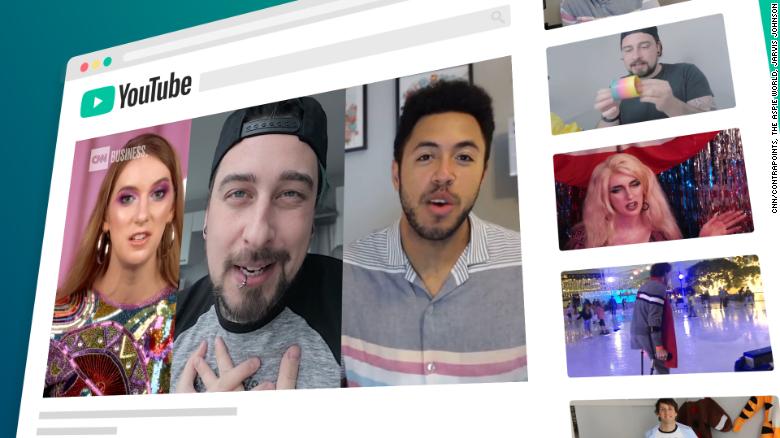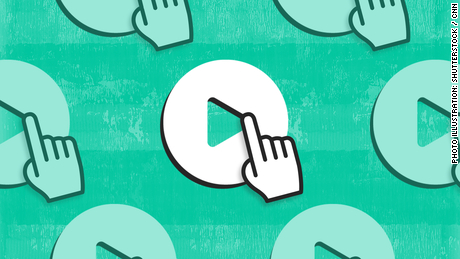YouTube burnout is real. Creators are struggling to cope
Updated 1435 GMT (2235 HKT) December 19, 2019
New York (CNN Business)For eight years, Kati Morton, a mental health expert, has used YouTube to discuss sensitive issues ranging from eating disorders to anxiety. But Morton's own well-being took a hit from the demands of her work on the platform.
At one point, she was uploading videos five times per week while maintaining her day job as a therapist. When balancing the two became too tiring, the 36-year-old quit her job to focus on YouTube full time (though she still has a small private practice). That helped for awhile, but then the exhaustion came back. She felt irritable, tearful and on edge -- all of which she realized were signs she wasn't taking care of herself.
"I had written my first book, and I was still uploading two videos a week at this time," Morton, who has 830,000 YouTube subscribers, told CNN Business. "My therapist was like, 'You need a vacation, like a real vacation.'"
In January 2018, she decided to take a one-month break from YouTube. She spent it at her mother's house watching movies, relaxing and sleeping.
Over the past few years, creators have started openly discussing feeling burnt out, which often comes from the pressure to constantly churn out new videos for their thousands -- sometimes millions -- of fans. PewDiePie, a controversial but incredibly popular star on YouTube with more than 100 million subscribers, said over the weekend that he will be taking a break from the platform. "I'm tired," he said in a video. "I'm feeling very tired."
Last month, YouTube creator Alex Wassabi told his 11.5 million subscribers that he would take a week off. "Recently, I have not been happy. I've been sad, confused, flustered," he said in a video. "But most of all, burnt out." He now uploads two videos a week rather than three as he did before.
Even Susan Wojcicki, the CEO of Google (GOOGL)-owned YouTube, felt the need recently to urge YouTube stars to take care of themselves and "invest in recovery." For some, however, that's a difficult investment to make.
The dark side of the influencer economy
In the nearly 15 years since YouTube launched with a video of one of its cofounders at the zoo, the platform has emerged as a powerhouse where people of all ages -- from an eight-year-old who reviews toys to "pasta grannies" who, well, make pasta -- can build up large followings and lucrative businesses to rival the success of television stars. By one estimate in Forbes, the 10 biggest YouTube creators earned a combined $180.5 million in 2018.
But there is a dark side: These creators face a constant pressure to put out an endless stream of content to satisfy their fans and, some fear, YouTube's algorithms. It's an issue that extends well beyond YouTube to the entire nascent world of the influencer economy.
Christian Collins, who has more than 2 million subscribers on YouTube, said when he was a teen he would often wake up at 5 am and work until 1 am producing material for his many social media platforms, including YouTube, Instagram, Vine, Snapchat and others.
"All I was doing was creating content. You get burnt out," Collins, now 23, told CNN Business. "I had more money than I could spend -- and I was super depressed. I had to quit everything and take a break for two years."
Collins might sound like an extreme, but he's not. "You can shoot a video in the morning and it could be posted that afternoon or even faster. So often times what [attracts] the audience for the creator is their pretty regular [pace] of putting content out there, so then that audience comes to expect that," said Stu Smith, VP of talent at Fullscreen, an influencer marketing firm, which is owned by CNN's parent company, WarnerMedia.
But he said maintaining that level of content for years can take a toll.
The burnout problem can be viewed as a sign of the times for the broader tech industry. Many people now feel the pressure to work and produce as much as humanly possible -- whether it be for a content platform or a ride-hailing service -- but without the benefits of being a full-time employee and with the fear that a black box algorithm working behind the scenes will somehow penalize them for falling short.
For YouTube creators, in particular, attempts to cope with the burden of a seemingly limitless demand for content can lead to a different kind of stress. YouTubers fear that not uploading videos consistently could disappoint their fans or potentially hurt their chances of being recommended by YouTube's algorithm. Others feel the need to keep creating new content in order to, hopefully, earn more money.
"There is so much content out there and competition," said Evan Asano, CEO of influencer marketing company Mediakix. "Everybody's fear and anxiety is that they're going to lose their fans, that taking a break means they could essentially go away as a YouTube star. People will forget about them."
To take breaks or not to take breaks
It's a pervasive concern for creators -- and one that YouTube's CEO addressed in her most recent quarterly letter to creators, published in late November.
"I've heard some creators say they feel like they can't take a break from filming because they're concerned their channel will suffer," Wojcicki wrote in the letter. "If you need to take some time off, your fans will understand. After all, they tune into your channel because of you."
Wojcicki also said YouTube's product team looked over data from the last six years. Across "millions" of channels and "hundreds" of different time frames for breaks, the team found that on average, channels had more views when they returned than they had right before they left.
That wasn't Drake McWhorter's experience, however. McWhorter, a YouTube creator with more than 268,000 subscribers, took a month off from the platform in 2016 to "get in a better head space." He said it took him a year to get back to the number of views he was getting before he took a break. So taking a breather again, doesn't feel like an option for him.
"YouTube is a treadmill," McWhorter said. "If you stop for a second, you're dead."
Asano believes this problem puts YouTube in a "tricky" position. "At one point, YouTube did really push for frequency and length of content," he said. "They don't want to tell everyone to take a month break... but they also don't want to be faulted for a huge amount of YouTube burnout."
YouTube pushed back on fears that its algorithm punishes creators for not uploading as often.
"We want to reassure creators that our systems do not take upload frequency or past video performance into account when recommending new videos to users," a YouTube spokesperson told CNN Business. "There is no pattern that leads to success on YouTube, but creating engaging content should always take priority over producing a certain volume of content."
Indeed, some YouTubers said breaks didn't cause their channel to suffer, including Morton, who has scaled back to uploading one video a week. There are even creators who appear to be thriving with this approach -- at least creatively.
Wassabi told his fans that his new reduced upload schedule will allow him to create better videos. As a way to encourage fans to keep coming back to his channel, he said he may upload surprise videos sometimes on Fridays.
YouTubers use platform to broadcast their concerns about burnout
Experts in the influencer marketing space recommend that creators focus on higher-quality videos over quantity, establish set working hours for themselves, and schedule time off, even if it's just a small break during the day.
But some YouTubers appear to believe part of the solution to dealing with burnout on the platform is more YouTube. Creators are now using the platform as a support group of sorts, McWhorter, for example, talks about mental health on his community chat tab. And YouTube as a company makes videos on the topic and offers courses on its "creator academy" website.
YouTube creator Elle Mills has been a major voice in the creator community when it comes to burnout. Earlier this year, she appeared on YouTube's creator channel to discuss the issue with two YouTube employees.
"You need to build trust with your audience and they need to know that they're going to come every week and be able to see a video from you," Mills said in the video. "Once you gain that community and that trust, then I think that's when you're able to be a little looser with your upload schedule."
But even Mills said she tries not to take too much time away from YouTube.
"I try to refrain from taking too many breaks because then people are less forgiving," she said. "Every once in a while, they're like 'OK we get it, it's been a lot' but if you keep on taking too many breaks, then I feel like the loyalty starts to fade."
As for McWhorter, he stays on YouTube in part because he feels a responsibility to his audience. But he still struggles with being a YouTuber.
"I'm so sick of this career," McWhorter said. "I would love to do literally anything else, but I've invested so much time and energy into this that it's the only career path that I have any real skill in. I'd have to start all over again."




















